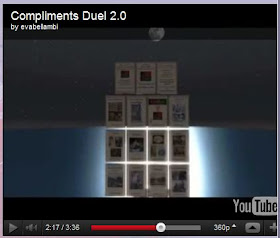
+
? What makes a
great Second Life experience?
? Which answers to that could be applied by SL Libraries to enhance their/our projects?
? For that matter, how might LIS courses apply it to improve their classes about LISinSL?
-- no answers here --
please help me find answers
Small details made a recent Hunt an entertaining experience for me. Significant little event management strategies and differences I found between merchants' strategies made me wonder whether some might improve SL library services. Of course, many librarians* work innovatively in Second Life and some may already be demonstrating answers to these questions--if so
I look forward to hearing (or googling up)
about them.
In case serendipity does not favour me with answers I plan to continue:
Direct Observations
Does that sound like a great excuse to participate in more hunts; and visit featured Destinations?
I will keep using Flickr for noting positive and negative details of my experiences, although I suspect my detachment might make me too fussy? However observing, noting and analysing observations takes time, particularly as I battle distractions (new clothes; editing; wanting to build; chatting).
Others have been around longer, participated more deeply, and will have actually tried and tested ideas, so:
Web searches
The answers are bound to be out there, however this method has its own distractions:
..
to which I was led by Pooky Amsterdam's
defense** of Second Life against ignorant (inadequately investigative) journalism, to which I was led by:
Nevertheless, such distractions demonstrate that there is a great diversity of
types of experience in Second Life. Will what counts as
great, differ if the information comes from:
- shopping experiences - Torley and his sources refer to some of the details I have witnessed: navigation, interesting and relevant decor, and even packaging (although disappointingly all the links there are deadends [found Suella's tips that he acknowledges; oh and the forum thread) [interestingly there has also been some academic research on positive influencers of SL shopping experiences - particularly spokes-avatar presence]
- role play or game experiences?
- exploration - (I've enjoyed sims' beauty travelling alone, but I've noticed guided tours available at times I wasn't - would anyone say they'd had a great SL guided tour experience--what made it so?)
- interpersonal experiences?
- artistic experiences - does the work of artists producing delightful art sims, photography, machinima and webcomics from and within Second Life suggest ideas? Could a visit to SL libraries become a more photogenic experience?

For thoroughness (but without sacrificing the excuse of value in my personal observations) I will look for more published views on Hunts***; however I will rely even more on others' views about what makes great in RP/gaming and social events - and how those might be applied to SL libraries.
Mundanely, I've frequently observed that maintenance is a massive issue for any set-up that expects their sim to support self-service. In what ways are great experiences set up to minimise failures of maintenance? Does the lack of Creation and modification dates in objects (and lack of distinction between creation and spawn in landmarks) bother anyone else?
The personal touch seems to be revealed as significant (
Jin & Bolebruch, 2009), but people can't be there all the time - and I've found some avatars' profiles enhance my experience while others grate - do you agree? I haven't analysed the source of the difference yet - are there details for using profiles to help make a great experience? [Wow,
Treacle Darlandes shared a great story which included the contribution of a profile to a great experience]
Is all this pondering - at least for the perspective of libraries in SL - a waste of time? Sometimes, like this moment, I lose sight (did I ever have one, I thought I did the other day) of what point a library really serves in Second Life (except as point of connection for librarians) --
tell me?
* * *
footnotes
*librarian = person who runs a library (YMMV)
**while the arguments on investigative negligence, and contribution of the importance of customer service to my own question, may be valid, the motivation for defense is naturally biased by Pooky's investment in Second Life as a medium for her services.
***For example, but not linked above for unreliability (the author (unnamed) claims three years SL business (unnamed) success (unevidenced)) though the information on
optimising business with hunts sounds sane.
+Photo Credit:
Nevery Lorakeet *LpD*'s
Futura artistic outfit for Second Life Birthday 8! CC2.0:BY-NC-ND
Reference (
I'll be interested to see how this appears, as dragged from Zotero):
Jin, S.-A. A., & Bolebruch, J. (2009). Avatar-based advertising in Second Life: The role of presence and attractiveness of virtual spokespersons. Journal of Interactive Advertising, 10(1). Retrieved from http://jiad.org/article124






